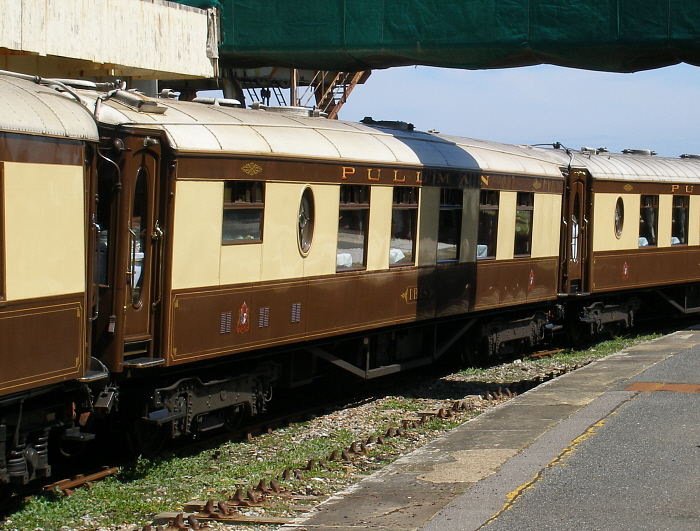
Ibis
Pullman Kitchen Car
This was one of eight
Pullman cars built in 1925 by the Birmingham Railway Carriage & Wagon Company, for use
on the Continent by the ‘’Compagnie Internationale des Wagons-Lits’’ (CIWL:
International Sleeping Car Company). Commissioned as a Kitchen Car, the vehicle
was outshopped in the familiar ‘’Old Standard’’ Umber and Crème Pullman colours
and christened ‘’Ibis’’. It was dispatched immediately to Italy, for use on the
Simplon Orient Express between Paris and Venice, via Milan. On arrival in Milan,
the coach was instantly de-named, simply becoming No. 52, but the Umber and
Crème livery was initially retained (it was from 1932 onwards that British-built
Pullman vehicles began appearing in standard Wagon-Lits colours: a lighter
shade of crème appeared in place of the British colour, and the chocolate lower
half became dark blue). In 1927, No. 52 was transferred to France, where it
plied the 100 miles between Paris and the northern French coast in the
‘’Deauville Express’’. During the following year, it was repatriated to the
United Kingdom, after a brief spell of running between the French capital and
the Belgian Port of Ostend, and arrived at the Midland Railway Carriage & Wagon
Company’s works in Birmingham for a complete rebuild. It re-emerged as a
twenty-seat Kitchen Car, complete with its former name ‘’Ibis’’, and arrived on
the Southern Railway’s Eastern Section, for use on the all-Pullman boat train
between London and the Channel Ports (this was re-launched as the ‘’Golden
Arrow’’ on 15th May 1929, and became the British Equivalent of the French’s
‘’Flèche d’Or’’, which had previously been inaugurated on 11th September 1926).
The ‘’Golden Arrow’’ was suspended on the outbreak of war on 3rd September 1939;
‘’Ibis’’ again featured in the train on resumption of the service on 15th April
1946. Just after the turn of the decade, the Pullman fleet of this luxury
service was improved upon: in 1951, seven new Pullman vehicles arrived from the
Birmingham Railway Carriage & Wagon Company (completing an order originally placed by
the LNER in 1938); these were followed in 1952 by a further three new Pullmans
which, unusually, had been constructed by the Pullman Car Company at its own
Preston Park Works. The arrival of the new-builds allowed a rolling stock
cascading exercise, and the older Pullmans, including ‘’Ibis’’, arrived on the
South Western Division. ‘’Ibis’’ found itself formed within Ocean Liner Special
services between Waterloo and Southampton, notably ‘’The Cunarder’’, an
all-Pullman service that was begun on 2nd July 1952. ‘’Ibis’’ survived in this
role until the end of steam-haulage on the South Western Division, in July 1967.
In the following year, the vehicle was purchased by the Dart Valley Railway, and
moved to Buckfastleigh, Devon. Here it remained for just two years: in 1970, a
move was made to the ex-GWR works at Tyseley, Birmingham, after ‘’Ibis’’ was
purchased by the ‘’Standard Gauge Steam Trust’’ (the organisation had begun
accumulating locomotives and rolling stock in 1966). The Tyseley operation was
absorbed into what became the ‘’Birmingham Railway Museum’’, and it was under
this auspices that ‘’Ibis’’ was purchased by the VSOE Company, in early 1981.
Restoration of the carriage took place at the company’s workshop in Carnforth,
Lancashire. This included a complete re-wire, to accommodate electric train
heating (ETH), and the removal of the Pullman Standard bogies in favour of the Gresley-designed
LNER type, as used on the 1951-completed Pullmans. Although the toilet was
removed, the carriage remained as a 20-seat Kitchen Car, complete with air
braking, and was ready in time for the official UK launch of the VSOE ‘’British
Pullman’’ at London Victoria, in November 1981.
Additional Notes [Ibis: As Built]
Tare (Empty Weight): 40 tons
Length: 63-foot 10-inches
Width: 8-foot 7-inches
No. of Seats: 20
Bogies: Pullman Standard
Route Availability (SR): 1
Schedule No: 245
Construction: Timber frame, clad with steel sheeting
21st June 2007

''Ibis'' is depicted at Folkestone Harbour, sandwiched in-between Pullman cars ''Audrey'' and ''Lucille''. The
shadow is that of the Southern Railway's concrete footbridge of 1938. David Glasspool
Return to the Kent Rail Homepage or alternatively, check for Updates.
Website & Copyright information - Links - Contact the Webmaster
All content is copyright © David Glasspool